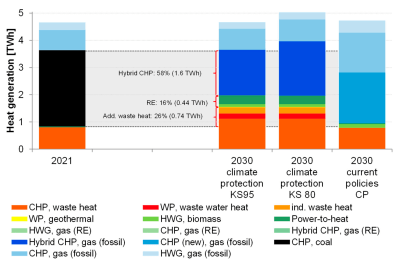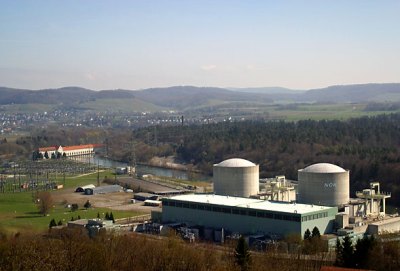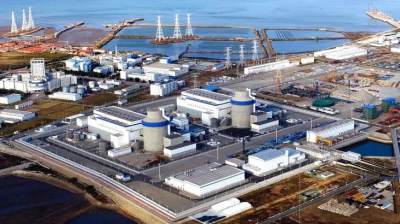
Most of modern society’s energy usage is spent on heating in some form, whether it is to heat water, raise the temperature in a room, or for use in industrial processes. This makes it an excellent target for improvements in efficiency and resilience, as well as in the effort to decarbonize the world’s energy production. Here district heating and similar solutions are likely to play a major role in the near future.
Over the past decades, a number of nations have either already build out extensive district heating grids, or are in the process of doing so. The main advantage of these heating grids is that they not only allow for more efficient, centralized generating of heat, but also allow for e.g. industrial waste heat to be used productively rather than wasted, even if most of the heat will come from either dedicated or cogeneration thermal plants.
Recently, district heating has received a big push in e.g. China in the form of nuclear cogeneration, while the potential of using thermal storage to buffer heat for later use along with the concept of tying data centers into heating grids are also being explored. Although district heating is hardly new, it may help to ease humanity into a low-carbon future, without losing a bit of comfort.
A Complicated History
The main benefit of district heating (DH) is their overall efficiency boost over many smaller heat sources, such as single household gas- or mineral oil-fired boilers, also due to using what would otherwise have been mostly waste heat. In addition, the sources that provide heat to the system can be highly diverse, even if coal has been the fuel of choice for heating grids in the West. The first generation DH systems were built in the late 19th century, with New York City’s steam-based network being a prime example of this. This type of first-generation system also shows the issues that prevented their adoption in many other cities.
The 2007 New York City steam explosion was one of twelve steam pipe explosions since 1987, with the 2007 explosion involving an 83 year old pipe rupturing and allowing the hot, pressurized steam to burst through the ground, seriously injuring people and causing a large amount of damage. The DH systems that were built starting around the 1930s and into the 1970s would instead use hot water, heated by cogeneration plants. While still pressurized, these systems do not pose the same safety risks as a pressurized steam system.
Rather than mostly a group of dedicated, coal-fired plants that feed a steam-based system, these second-generation DH systems and the subsequent improvements (like insulated pipes instead of plain concrete pipes) would generally be based around cogenerating thermal plants, so that nearby cities and communities could be provided with both heat and electricity. This approach found a big uptake in the Scandinavian countries, as well as in the former Soviet Union.

The build-out of DH systems has largely stalled for the past decades, however. Due to the availability of cheap natural gas, and in the case of countries like Norway and France due to low electricity prices, the financial incentive to put in the pipes for a new DH system or to extend an existing DH system was often absent. Many existing DH systems also had their sources switched from low-carbon nuclear to fossil fuels, as was the case with DH grids in the former USSR. East Germany’s Greifswald and similar cogenerating VVER PWRs were shut down in the 1990s, with coal and gas plants taking their place.
In the March 1989 IAEA Bulletin, Losev et al. describe the DH plans that existed back then to further extend the use of nuclear power plant cogeneration into the European part of the USSR. Of course, with the collapse of the USSR in 1991, the few DH systems that did get implemented since then use primarily fossil fuels as their sources.
Cities such as Berlin are a good example here, with its two (Western & Eastern) separate DH systems. Although this network extends to essentially just the size of the city before the USSR’s collapse, it is still the largest DH system of Germany. Currently Berlin is trying to find ways to move away from the carbon-heavy coal-fired plants that provide the bulk of its heat supply, with Gonzalez-Salazar et al. (2020) providing a few possible scenarios.
In their evaluation of alternative sources, they found that industrial waste heat could provide a small contribution, with the bulk being taken up by burning (heavily polluting) communal solid waste (trash) and biomass, primarily in the form of wood chips in the current coal plants. The overwhelming majority of the heat supply would be provided by fossil gas (NG), however, with the idea that NG alternatives like (green) hydrogen could be swapped in at some (distant) point in the future.
In their ideal scenarios, power-to-heat (P2H) would also be used, which involves converting electricity into heat using technologies like resistive heating, heat pumps, etc.
Finding The Right Balance

As the situation in Berlin and New York City shows, having a DH system doesn’t necessarily mean that it is low-carbon, or easily converted from a pollution-belching monstrosity. In addition to integrating low-carbon heat sources, the fact remains that the siting of the heat supply is important for the system’s efficiency. For thermal plants and sources of industrial waste heat, this means that they have to be located sufficiently close to the consumer, generally within a few tens of kilometers to minimize heat losses.
This also plays a role when it comes to the P2H scenario of using excess power from solar and wind power installations to heat up some form of thermal storage. Since the storage has to be placed sufficiently close to the end-user, this means that the electrical power has to be transferred via transmission lines to this storage facility. Without sufficient available capacity on these transmission lines, the excess power would still have to be curtailed. Relying solely on excess power would also mean a highly variable heat input into the system, requiring some kind of backup heat supply, like fossil fuels or nuclear power, or accept periods of unfulfilled heating demands.
The most efficient scenario is probably that of the traditional nuclear power cogenerating plants, as used heavily by former Soviet states, as well as by Switzerland at its Beznau nuclear power plant. This plant was retrofitted in 1984 to provide district heating to nearby communities, which had the additional benefit of less waste heat ending up in the nearby river, as well as saving over 14 million cubic meters of natural gas by the connected households.
An aspect of such cogenerating plants is that part of the steam is used for the DH system rather than for producing electricity. Since this steam is extracted after it has already (partially) expanded in the turbine stage, the reduction in electricity production is generally minimal. Even so, it is conceivable that by adding thermal storage to the DH system and accepting waste heat from industrial processes, as well as data centers, etc. less steam would have to be diverted, allowing for more electricity production, without otherwise affecting the system.
Using P2H in this scenario would likely make very little sense, as adding more heat would free up more electricity, but P2H only makes sense if there is already excess electricity on the local grid, making it essentially useless. Using relatively constant sources of heat, like data centers and aluminium smelting facilities (as seen in e.g. Norway), could however provide additional redundant supplies of heat to the system.
Increase The Heat

Having continuous access to heating is important and a matter of survival in many nations, including during extreme weather events like the February 2021 Texas winter storms that saw many households cut off from both gas and electricity. Similarly, many industries require a constant source of heat, such as in glass and steel manufacturing, as well as the petrochemical industry. These heating demands scale across a wide range of temperatures, from around a 100°C for DH systems, to 300 to ~1000°C for industrial heat.
The reliability demand reinforces the importance of having reliable sources proving the heat. Here nuclear plants are the sole type of source that has a capacity factor of >90%, and no reliance on daily, weekly or even monthly refueling. This is also why chemical plants and other industries that seek to move away from fossil fuels have a strong interest in small modular reactors for industrial process heat, as even brief drops in supplied heat can grind production to a halt, or even destroy a manufacturing line.
High-temperature (helium) gas-cooled reactors (HTRs) – like the Chinese HTR-PM – reach much higher temperatures than traditional water-cooled (LWR or HWR) reactors, making them suitable for an even larger number of industrial processes, while also providing electrical power. This should ideally provide industrial processes with heat and power 24/7 for the years that the fuel lasts, making it a very attractive, economical and low-carbon source.

The reliability of cogenerating nuclear plants has been proven over many decades, which has made it an obvious choice for nations like China, as they seek to find alternatives for coal-fired plants in their DH systems. The Chinese city of Haiyang, in Shandong province, is currently working to fully convert its DH system from coal-fired boilers to nuclear cogeneration. As reported, the heat from the AP-1000 Haiyang-1 reactor alone was sufficient to replace 12 coal-fired boilers.
The goal is to produce enough heat for the entire city of Haiyang using this single nuclear plant, along with electrical power and heat for desalination, effectively eliminating most fossil fuel usage by the city’s inhabitants.
Beyond The District
An inevitable part of a DH system is that the large diameter insulated pipes have to be buried into the ground, which can be rather disruptive. Depending on the situation, a heat pump system can be an acceptable alternative, providing much higher efficiency than a simple resistive heating system. These do of course require a reliable source of electrical power, but heat pump systems can be installed at the whim of a home owner.
Since 2004 the EU has had the CHP Directive (Combined Heat and Power) in force, which is supposed to increase the proliferation of cogeneration and district heating within the EU. Despite this, the biggest observable change has often been households switching from mineral oil for heating to gas (due to perceived cost savings), along with a push for heat pumps.
When comparing the EU’s heating decarbonization efforts to nations which have fully embraced using nuclear power for DH and industrial heat, it raises many questions about the feasibility of creating a low-carbon DH system without involving nuclear power. It’ll be interesting to see how things work out in this regard the coming years, especially with the current energy crisis having completely torpedoed the economics behind involving fossil gas in any way.
[Heading image: The Akademik Lomonosov floating nuclear power plant, moored at Pevek, Russia. It provides power and heat to the isolated community.]
Cogeneration And District Heating For Comfortable Homes And Happy Factories
Source: Manila Flash Report
0 Comments